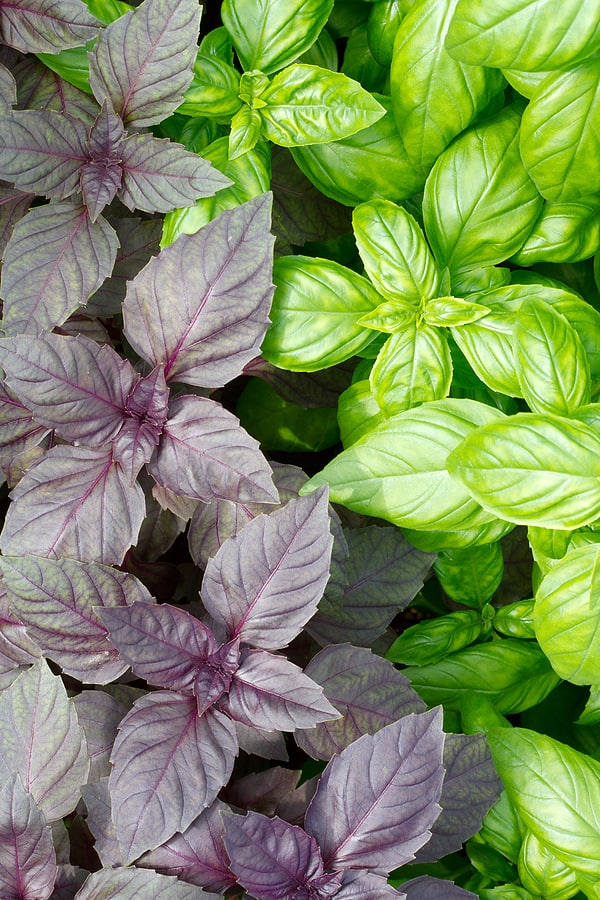Sharing is caring!
Basil has a flavor sweet and pungent and pungent and sweet—so unique it is sometimes described as “basil-y.”
Basil is the quintessential herb for seasoning tomatoes. It goes well with pasta, salads, eggs, cheeses, vegetables, fish, seafood, fowl, and pork, but unlike many other herbs it does not go well with vinegar or other herbs.

Basil blends perfectly with olive oil and lemon, but is so volatile that is always best added at the end of cooking—not during.
Basil ground with extra-virgin olive oil, minced garlic, pine nuts, and Parmesan cheese is Italian pesto. (Just mix to taste and pulse-blend rapidly in a blender.)
Use basil’s aromatic leaves fresh or dried in soups—but most flavorful fresh or fresh frozen.
Known best for its clean, heavy flavor with a licorice overtone aroma and flavor is Sweet Basil, but there are nearly 60 varieties of basil.
Ten basils worth growing and using in the kitchen:
Sweet basil (Ocimum basilicum): Mint and spice with some anise; green flavor with a slight pungency; sweetest and mildest basil; use for pesto; will work for any recipe that calls for basil; use fresh or dry; green leaves, smooth to slightly puckered, strongly veined, sometimes toothed, about 3 inches long and 1½ inches wide; grows 24 inches tall by 15 inches wide.
Genovese basil (O. basilicaum): spice, licorice, and mint with subtle pungency; holds up well to cooking; use for pesto sauces; dark green savoyed leaves with noticeable veins; grows to 24 inches tall and wide.
Spicy Globe (O. basilicum x O. americanum): spicy and pungent basil flavor with mint tones; slightly hot; most popular mini-leaved basil; bright green, delicately toothed leaves ¾ inches long by ½ inch wide; grows 10 inches tall by 14 inches wide.
Lemon basil (O. basilicum citridorum): distinct lemony flavor and aroma with floral tones reminiscent of green tea with a zing of mint; subtle flavor used for delicate-flavored main course, iced teas, baked goods, fruity salad dressings, fruit sauces, ice creams, and sorbets; used in Thai and Vietnamese cooking; egg-shaped light green leaves; grows 16 inches tall and 10 inches wide.
Purple Ruffles (O. basilicum ‘Crispum’): cinnamon-like flavor; use on salads; dark purple, ruffled leaves 3 inches long by 1¾ inches wide; plant to 16 inches tall by 10 inches wide; grows 27 inches tall by 17 inches wide.
Dark Opal (O. basilicum x O. forskolei): citrus zest flavor followed by anise with a touch of mint; use in salad mixes or to color basil vinegar pink; nearly black, toothed leaves about 3 inches long and 1½ inches wide; plant 19 inches tall by 13 inches wide. Red Rubin (O. basilica x O. forskolei) is improved Dark Opal: dark purple-red egg-shaped and toothed leaves, 3½ inches long by 1½ inches wide; grows 12 inches tall and 8 inches wide
Thai basil (O. basilicum): perfumed sweet licorice flavor with hints of mint and spice; complex flavor; essential in Southeast Asian cooking; dark green pointy leaves with serrated edges to 3½ inches long and 1 inch wide; grows 20 inches tall and wide.
Siam Queen (O. basilicum ‘Siam Queen’): sweet, spicy and robust licorice flavor; use on summer squash and pasta; Thai type basil with oval, pointed, dark green leaves, 3 to 4 inches long to 2 inches wide;; grows 15 inches tall and wide.
Cinnamon basil (O. basilicum): citrus zest and perfumed cinnamon spice flavor with anise and mint tones, warm and pungent; use for herbal teas; pointy, green leaves 1 to 3 inches long by 1¼ inches wide; grows 36 inches tall and 19 inches wide.
Licorice basil (O. basilicum): rich licorice taste followed by spicy mint flavor with clove and cinnamon tones; good with fish or to flavor candy; heart-shaped green leaves about 3 inches long and 1 ½ inches wide; grows 30 inches tall and 17 inches wide.
Basil growing basics:
- Start seed indoors 4 to 6 weeks before the last frost, or direct sow when all danger of frost has passed. Warm the soil with black plastic to speed germination.
- Do not set transplant to the garden until night temperatures average 60°F or greater.
- Plant in well-drained loamy soil with a pH of 6 to 6.5.
- Plant in a sunny location with at least 8 hours of sun each day.
- Keep the soil evenly moist; do not over or underwater; too much or too little water will affect the flavor.
- Cut the plant back to just above the bottom two sets of leaves once a month to prevent the plant from flowering. Pruning yields more leaves.
- Harvest about 80 days after sowing; harvest in the evening and refrigerate to preserve the best flavor.
- At the end of the season save seed from open-pollinated varieties; cut the flowers and place in a bag until seedhead dries. Rub the seedhead to separate seed from chaff.
Keeping basil fresh after harvest:
Wrap fresh basil in a slightly damp towel and place it in the refrigerator. Wash before using. Preserve fresh basil leaves in olive oil or make them into a smooth paste by mixing with oil in a blender. Basil loses much of its taste when dried, so freeze it whole or chopped or cover it with stock or water and freeze it in cubes to use in soups, sauces, and stews.















